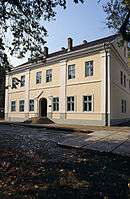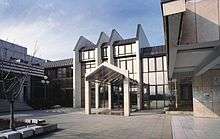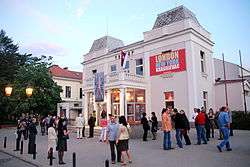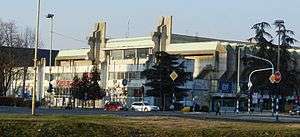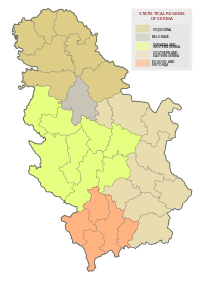Kragujevac
| Kragujevac Крагујевац | |||||||||
|---|---|---|---|---|---|---|---|---|---|
| City and municipality | |||||||||
| City of Kragujevac | |||||||||
Kragujevac photomontage | |||||||||
| |||||||||
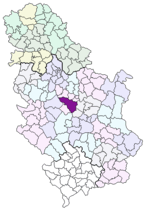 Location of Kragujevac within Serbia | |||||||||
| Coordinates: 44°00′40″N 20°54′40″E / 44.01111°N 20.91111°ECoordinates: 44°00′40″N 20°54′40″E / 44.01111°N 20.91111°E | |||||||||
| Country | Serbia | ||||||||
| District | Šumadija | ||||||||
| Municipalities | 5 | ||||||||
| Founded | 1476 | ||||||||
| Government | |||||||||
| • Mayor | Radomir Nikolić | ||||||||
| • Ruling parties | Serbian Progressive Party | ||||||||
| Area | |||||||||
| • City and municipality | 835 km2 (322 sq mi) | ||||||||
| Population (2011)[1] | |||||||||
| • City and municipality | 179,417 | ||||||||
| • Urban |
| ||||||||
| Time zone | CET (UTC+1) | ||||||||
| • Summer (DST) | CEST (UTC+2) | ||||||||
| Postal code | 34000 | ||||||||
| Area code(s) | (+381) 34 | ||||||||
| Car plates | KG | ||||||||
| Website | www.kragujevac.rs | ||||||||
Kragujevac (Serbian Cyrillic: Крагујевац, pronounced [krǎɡujeʋat͡s]) is the fourth largest city in Serbia, the administrative centre of Šumadija District. It is situated on the banks of the Lepenica River. According to the official results of the 2011 census, the city has a population of 179,417 inhabitants.
Kragujevac was the first capital of modern Serbia (1818–39); the first constitution in the Balkans was proclaimed in the city in 1835. The city's first grammar school and printworks were both established in 1833, followed by the professional National theatre (1835), Military academy (1837) and the first full-fledged university in the newly independent Serbia (1838). Kragujevac was the site of a massacre by the Nazis (1941), in which 2,778 Serb men and boys were murdered. Contemporary Kragujevac is known for its munitions (Zastava Arms) and automobile industry (Fiat Automobili Srbija).
As an important university center, the University of Kragujevac was established on 21 May 1976, from departments of the University of Belgrade Faculty of Mechanical Engineering and Faculty of Economics, which began to work in late 1960s. The University of Kragujevac includes twelve schools, six located in Kragujevac with others located in Čačak, Kraljevo, Jagodina, Užice and Vrnjačka Banja. The city has two scientific research institutes: the Institute for Field Crops in Kragujevac and Fruit and Grape Research Institute in Čačak.
History
Early and medieval

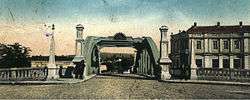
The name of the town derived from the archaic Serbian word "kraguj", which is a name used for a particular species of hawk, thus the name means "hawk's nesting place".[2] Kragujevac experienced a lot of historical turbulence, not always without severe casualties. Over 200 archaeological sites in Šumadija confirm that the region's first human settlements occurred 40,000 years ago, during the Paleolithic era.
Before the arrival of the Slavs, the territory of present city was inhabited by the Illyrians and Romans. This territory was captured from Byzantium by Stefan Nemanja, who consolidated the Serbian state in the twelfth century. In the Middle Ages, the area of modern Kragujevac was part of several Serbian states. Kragujevac was first mentioned in the medieval period as related to the public square built in a settlement, while the first written mention of the city was in the Ottoman Tapu-Defter in 1476.[3]
Ottoman documents from the 15th century refer to it as a "village of Kragujevdza". The town itself gained prominence during the Ottoman period (1459–1804) as the central point in the Belgrade Pashaluk (Sanjak of Smederevo).[4] In 1718-39, the town was controlled by the Habsburg Monarchy and was part of the Habsburg Kingdom of Serbia. In 1788, it was part of Kočina Krajina, an area controlled by the Serb rebels, while in 1789-90 it was again controlled by the Habsburg Monarchy.[5]
Early modern period
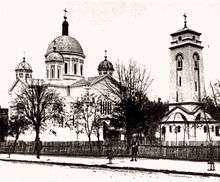

The city has been devastated many times and has suffered great losses of life in a number of wars throughout history. It began to prosper after Serbia's liberation from Turkish rule in 1818, when Prince Miloš Obrenović proclaimed it the capital of the new Serbian State and built the Amidža Konak.[6] The first Serbian constitution was proclaimed here in 1835 and the first idea of independent electoral democracy. The first law on the printing press was passed in Kragujevac in 1870. Kragujevac, the capital, was developing and cherishing modern, progressive, free ideas and resembled many European capitals of that time.[7]
Apart from contemporary political influence, Kragujevac became the cultural and educational center of Serbia. Important institutions built during that time include Serbia's first secondary school (Gimnazija), first pharmacy, and first printing press.[8] The turning point in the overall development of Kragujevac was in 1851 when the Cannon Foundry began production, beginning a new era in the city's economic development. The main industry of the 19th and 20th century was military production. Kragujevac became one of Serbia's largest exporters in 1886, when the main Belgrade–Niš railway connected through Kragujevac.
During World War I, Kragujevac again became the capital of Serbia (1914–1915), and the seat of many state institutions; even the Supreme Army Command was housed within the court house building.[9] During the war, Kragujevac lost 15% of its population. On the night of June 2, 1918, a group of occupying Slovak soldiers from the Austro-Hungarian 71st infantry regiment mutinied in the city center. The soldiers, led by Viktor Kolibik, had recently returned from captivity in Russia and were to be immediately deployed to the Italian Front. The mutiny failed and 44 mutineers were executed.[10]
Interbellum period
The social aspect, especially theater life, in Kragujevac between the two wars was very vibrant. The first cultural event in liberated Kragujevac occurred in 1918. That was the establishment of the Theater Gundulic that worked only one season and moved to Belgrade.[11]
Following the model of Academic Theater in Belgrade, the Kragujevac Scholars Academic Theater was founded in 1924. It was a theater that supported contemporary ideas, modern approach to stage, live word and repertoire, thus gaining the reputation of a serious art organization.[12] There were many other cultural institutions in the city, which began to grow into a large cultural and industrial hub of Central Serbia.
WWII and the Kragujevac massacre
Kragujevac underwent a number of ordeals, the worst probably having been the October massacre during World War II. The Kragujevac massacre was the shooting of 2,300 to 5,000 civilians—mostly Serbs and Roma— by Nazi soldiers between 19–21 October 1941.[13] Staniša Brkić, curator of The Museum of 21 October, published a book in 2007 in which he listed the names and personal data of 2,796 victims.[14] As noted by Stevan Pavlowitch, Serbian and German scholars have subsequently agreed on the figure of 2,778.[15]
The shootings were conducted in retaliation for a partisan attack on German soldiers. 50 people were to be murdered for every German soldier who was wounded, while 100 were to be murdered if a German soldier was killed. Among the murdered was a class of pupils from Kragujevac First Grammar School. A monument for the executed pupils is a symbol of the city.[16] This atrocity has inspired a poem called Krvava Bajka (Bloody Fairy Tale) by Desanka Maksimović.[17] The site of the shootings was turned into a memorial park in 1953, which covers an area of 352 hectares. At the entrance to the memorial park, in 1976 was built a monumental museum "21. October", dedicated to the victims.
Post-war city
In the post-war period, Kragujevac developed more industry. Its main exports were passenger cars, trucks and industrial vehicles, hunting arms, industrial chains, leather, and textiles. The biggest industry, and the city's main employer was Zastava, which employed tens of thousands people.[18] The first car of the Zastava Automobiles car company, FIAT 750, was produced in 1955, on the basis of a license of the Italian FIAT car company. In the following three decades, around five million passenger cars (FIAT 750, Zastava 1300, Zastava 101, Zastava 128, Zastava Jugo, Jugo Florida) was produced, and exported to 74 countries worldwide.[19] The city industry suffered under economic sanctions during the Milošević era, and was all but destroyed by the NATO bombing campaign in 1999.[20]
Geography
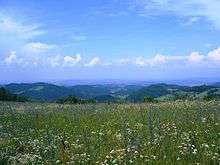
Kragujevac lies 180 metres (591 feet) above sea level. The coordinates of Kragujevac are 44°00'40 of northern latitude and 20°54'40 of eastern longitude. It is located in the valley of the river Lepenica. The city covers an area of 835 square kilometres (322 sq mi), surrounded with slopes of mountains Rudnik, Crni Vrh and Gledić mountains. Kragujevac is administrative center of Šumadija, region characterized by hilly - mountainous land.
Kragujevac has developed transportation infrastructure. The city can be reached by five important roadways from: a) Belgrade, via Batocina, by State road (IB class) number 15; b) the Montenegrin border, via Novi Pazar and Kraljevo, by State road (IB class) number 15; c) Belgrade, via Mladenovac and Topola, by State road (IB class) number 16; d) Jagodina, via Donja Sabanta, by State road (class II) number 170; e) Gornji Milanovac, via Bare, by State road (class II) number 176. Kragujevac is connected by bus lines with almost all cities in the country. The most frequent departures (every half-hour) are to Belgrade. The central bus station is about a kilometer away from the city center. Kragujevac can be reached by train, although the city is located outside the main railway lines. The central train Station is located close to the central bus station.
Climate
Kragujevac has temperate continental climate, characterized by relatively cold winters and hot summers. The coldest month is January and the warmest July. The months with the most rainfall are May and June, and months with the least rainfall are January, February and March. Winds most often blow from southwest and northwest, while they often blow from Southeast in January, February and March. The average number of snowy days is 30.
| Climate data for Kragujevac (1981-2010) | |||||||||||||
|---|---|---|---|---|---|---|---|---|---|---|---|---|---|
| Month | Jan | Feb | Mar | Apr | May | Jun | Jul | Aug | Sep | Oct | Nov | Dec | Year |
| Record high °C (°F) | 20.6 (69.1) |
25.0 (77) |
29.4 (84.9) |
31.4 (88.5) |
35.4 (95.7) |
39.4 (102.9) |
43.9 (111) |
40.4 (104.7) |
37.4 (99.3) |
32.6 (90.7) |
27.6 (81.7) |
21.0 (69.8) |
43.9 (111) |
| Average high °C (°F) | 5.2 (41.4) |
7.3 (45.1) |
12.5 (54.5) |
17.8 (64) |
23.0 (73.4) |
26.1 (79) |
28.7 (83.7) |
28.8 (83.8) |
24.0 (75.2) |
18.5 (65.3) |
11.6 (52.9) |
6.2 (43.2) |
17.5 (63.5) |
| Daily mean °C (°F) | 0.9 (33.6) |
2.3 (36.1) |
6.6 (43.9) |
11.7 (53.1) |
16.7 (62.1) |
20.0 (68) |
21.9 (71.4) |
21.5 (70.7) |
16.9 (62.4) |
11.9 (53.4) |
6.4 (43.5) |
2.1 (35.8) |
11.6 (52.9) |
| Average low °C (°F) | −2.6 (27.3) |
−1.9 (28.6) |
1.8 (35.2) |
5.9 (42.6) |
10.6 (51.1) |
13.8 (56.8) |
15.3 (59.5) |
15.1 (59.2) |
11.3 (52.3) |
7.1 (44.8) |
2.5 (36.5) |
−1.1 (30) |
6.5 (43.7) |
| Record low °C (°F) | −27.6 (−17.7) |
−23.8 (−10.8) |
−18.3 (−0.9) |
−5.8 (21.6) |
−0.6 (30.9) |
2.7 (36.9) |
7.2 (45) |
4.6 (40.3) |
−2.2 (28) |
−6.6 (20.1) |
−16.4 (2.5) |
−20.7 (−5.3) |
−27.6 (−17.7) |
| Average precipitation mm (inches) | 37.9 (1.492) |
37.0 (1.457) |
42.3 (1.665) |
53.9 (2.122) |
58.7 (2.311) |
76.4 (3.008) |
57.7 (2.272) |
58.6 (2.307) |
51.6 (2.031) |
48.9 (1.925) |
49.5 (1.949) |
45.8 (1.803) |
618.5 (24.35) |
| Average precipitation days (≥ 0.1 mm) | 12 | 12 | 11 | 12 | 13 | 12 | 9 | 8 | 9 | 10 | 11 | 13 | 132 |
| Average relative humidity (%) | 79 | 75 | 69 | 67 | 68 | 68 | 65 | 67 | 72 | 75 | 77 | 81 | 72 |
| Mean monthly sunshine hours | 71.9 | 94.8 | 144.5 | 180.4 | 234.5 | 257.4 | 293.5 | 275.5 | 200.8 | 152.1 | 93.9 | 63.7 | 2,078.1 |
| Source: Republic Hydrometeorological Service of Serbia[21] | |||||||||||||
Cityscape
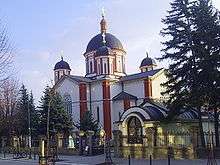
The architecture of Kragujevac displays a fusion of two different styles—traditional Turkish (nowadays almost completely gone) and 19th century Vienna Secession style.[22]
Modern conceptions also appear throughout the city, firstly in the shape of post-war concrete (usually apartments designed to house those left homeless during World War II), and secondly the up-to-date glass offices reflecting the ambitious business aspects of modern architects. Some important buildings in Kragujevac include:


- The old church of Descent of the Holy Spirit was built in 1818, as a part of Prince Miloš' court. Its interior was decorated from 1818 to 1822. The new belfry was built in 1907.
- The Old Parliament was built in the court of the church where the first parliamentary meeting was held in 1859. Many events of great historical importance, such as verifying the Berlin Congress decision about the independence of Serbia, took place there. After undergoing reconstruction in 1992, the building was converted into a museum.
- The Amidža Konak was built by Prince Miloš in 1820 as a residential house. It is one of the finest examples of regional architecture in Serbia. It now houses an exhibition from the National Museum.
- The Prince Mihailo Konak was built in 1860. Its architecture blends local tradition with European architectural concepts. The building is now the National Museum.
- The High School (Gimnazija) was built between 1885-87 according to designs from the Ministry of Civil Engineering. It is one of the city's oldest edifices designed in a European style, in the tradition of the oldest Serbian Gimnazija from 1833. Such famous Serbian scientists, artists and politicians as Svetozar Marković, Nikola Pašić, and Vojvoda Radomir Putnik, were educated in this school.
The Upper (Great) Park is the greatest park in Kragujevac. It was established in 1898. It is covered with more than 10 hectares (25 acres) of greeenery, and a dense canopy of century-old trees, renovated walkways and benches are the right place for rest, walk and relaxation. In the park and its immediate vicinity there are sports facilities for basketball, football, volleyball, tennis, as well as indoor and outdoor swimming pools. Lower (Small) Park is located in the city center, within the Milos Wreath complex. At its center there is a monument to the Fallen People of Šumadija. The Ilina Voda park, a legacy of Svetozar Andrejević, was established in 1900. It covers an area of 7 hectares (17 acres).
There is a fountain with a small waterfall, five mini lakes connected by a small stream, and a small zoo with about 100 animals and a garden with various types of trees characteristic of Šumadija. The curiosity in the park is the largest sculpture of Easter eggs (3 metres (10 ft) high) in Europe and the second in the world; made from recycled metal, set in 2004.[23] Scenic attractions nearby include the Aranđelovac, Gornji Milanovac, Vrnjačka Banja, and Mataruška Banja, Karađorđe's castle, the Church of Saint George in Topola 40 kilometres (25 miles) away, the Old Kalenić monastery 55 kilometres (34 miles) away, the resorts of Rogot (28 km (17 mi)) and Stragari (34 km (21 mi)) with the old Blagoveštenje and Voljavča monasteries.
Economy
Kragujevac has been an important industrial and trading center of Serbia for more than two centuries. The city is known for its automotive and firearms industry. The former state-owned Zastava Automobiles company was purchased by Fiat in 2008, with Fiat pledging to invest 700 million euros into the company now renamed as Fiat Automobiles Serbia. Weapons manufacturing in Kragujevac began in 1853 and has since grown to become Serbia's primary supplier of firearms through the Zastava Arms corporation.[19] Today, Zastava Arms exports more than 95% of its products to over forty countries in the world. By the decisions of the Ministry of Defense of the Serbian Government, Zastava Arms became a part of the Defense Industry of Serbia in 2003. The most important partners of Zastava Arms are Yugoimport SDPR, Army and Police of Serbia, Century Arms, and International Golden Group.
Johnson Controls, Rapp Marine Group, Metro Cash and Carry, Mercator and Plaza Centers established their operations in Kragujevac. The most important local companies include Forma Ideale, Blažeks (furniture production), KUČ Company (dairy producer), Jagger and Valentino (fashion production), Flores (brandy), Prizma (medical equipment production and distribution), Agromarket and Agrojevtic.
The Kragujevac Fair was established in 2005 thanks to the project "Support to the development and promotion of regional economy through development of City Fair". It comprises 1,600 square metres (17,222 sq ft) of area dedicated to trade and exhibitions and 1,000 square metres (10,764 sq ft) of area for other activities (administration, Media center, restaurant etc.).[24]
Demographics
Out of 179,417 inhabitants of administrative area, around 65% is of working age. Total number of employees in September 2012 was 41,457. Majority of persons of working age have secondary education (51.34%) or primary education (21,22%), while 14% have college or university degree.[25]
Around 93% of total city area is covered with water supply system, 78% with sewage system, 72% with natural gas supply network, and 92% with cell phone networks.[26]
Education
There are 22 primary and 8 secondary schools in Kragujevac.[27] There are also 3 special schools: School for hearing impaired children,[28] Music school Dr Miloje Milojevic,[29] and the Vukasin Markovic School (for children with disabilities).[30]
The University of Kragujevac was established on 21 May 1976 although the first higher education institutions started with operations in 1960 as departments of the University of Belgrade. It is fourth largest university in Serbia and is organized in 12 faculties and two institutes which are spread over six cities (Kragujevac, Cacak, Kraljevo, Uzice, Jagodina and Vrnjačka Banja) of the Central Serbia region which covers an area populated by 2,500,000 people. Around 16.000 students is currently enrolled at the university. It has around 1.350 employees out of which 900 is teaching and research staff.[31]
The University Library in Kragujevac is of generally scientific character, and its primary users are university teaching staff and students. It takes space of 1,500 square meters and includes several storage rooms, reading area and University Gallery. Library takes care of around 100,000 copies of books, 2,500 doctoral and master thesis, 450 titles of domestic journals and 105 titles of foreign journals.[32]
Culture
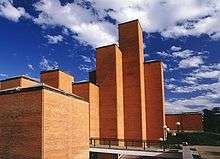

There are many cultural institutions in Kragujevac that have gained regional, and some of them even national significance in the field of arts and culture. The most important of these institutions are:
- Knjaževsko-srpski teatar (founded in 1835),
- National Library "Vuk Karadžić" (1866),
- Cultural and Artistic Group "Abrasević" (1904).
- The "Kragujevac October" Memorial Park, located in Šumarice, commemorates the tragic events of 21 October 1941.
- The National Museum has various displays including those pertaining to archeology, ethnic diversity, the history of Kragujevac and Šumadija and many paintings. The archeology department has a rich collection of 10,000 display items and over 100,000 study items. The painting department has over 1,000 pieces of prominent Serbian art of extraordinary value.[33]
- The "Old Foundry Museum" is located within the old gun foundry, the oldest surviving part of the military factory with military - artisan school, the first of its kind in the principality of Serbia. Museum is founded in 1953 and exhibits the history of industrial development in Kragujevac and Serbia. It has the collection of 5,800 pieces: weapons and equipment, machines and tools, archive material, photos, paintings, trophies and medals.[34]
- The Historical Archives of Šumadija collects and files the archives and issues of the seven municipalities of Šumadija and has at its disposal 700 metres (2,297 feet) of archive issues with 780 registries and hundreds of thousands of original historical documents.
There are three fine and applied arts associations in Kragujevac: the Art KG, the branch of the Serbian Association of Painters ULUS and the Association of Painters of Kragujevac (ULUK).
The most important annual and biannual cultural events include:
- International Festival of Chamber Choir Music
- International Festival of Chamber Music
- The Best Serbian Theatrical Performances Festival
- International Small Forms Theatre Festival
- "Arsenal Fest" (a music festival)
- International Saloon of Antiwar Cartoons
- International Art Workshop "Balkan Bridges"
- International Jazz Festival
- International Puppet Theatre Festival
Sports
Kragujevac is home to Čika Dača Stadium, which is the third largest stadium in Serbia by seat capacity. The largest and most important sports association in Kragujevac is Radnički, which brings together 19 clubs: football, athletics, volleyball, handball, boxing, chess, wrestling and others. FK Radnički 1923 is the city's most successful football club and competes in the Serbian SuperLiga. However, in football, Kragujevac is also known for having the oldest Serbian club, FK Šumadija 1903 (although FK Bačka 1901 is the oldest club in present-day Serbia, at time of its foundation was located in Austro-Hungary while Kragujevac was in Serbia, so that is why Šumadija is the oldest Serbian club, while Bačka is the oldest club in Serbia).
KK Radnički is the city's premier basketball team which, besides the Basketball League of Serbia it also competes in the Adriatic Basketball League. Volleyball club Radnički is one of strongest volleyball teams in Serbia, and water polo club VK Radnički Kragujevac competes in the Serbian Water polo League A and has won the domestic league and the LEN Trophy in 2013. The city is home to the CROSS OVER Basketball Summer Camp, and Bandy Federation of Serbia.[35] The team of Kragujevac plays against the one from Subotica.
Faculty of Economics of the University in Kragujevac is founder of the futsal club KMF Ekonomac. The club was founded by Professor Veroljub Dugalić, several teaching assistants and a group of Faculty of Economics students on 7 November 2000. The club is playing in the Prva Futsal Liga and has won the Serbian championship eight times and Serbian Futsal Cup twice.
Municipalities and settlements

The city of Kragujevac is divided into the following municipalities:

- Settlements
List of settlements in the municipalities of Kragujevac:
|
|
Demographics
Ethnic groups in the municipal area of Kragujevac (including all municipalities) as of 2011 are the following:
|
Ethnicity |
Number |
|---|---|
| Serbs | 172,052 |
| Roma | 1,482 |
| Montenegrins | 645 |
| Macedonians | 297 |
| Croats | 192 |
| Yugoslavs | 175 |
| Gorani | 101 |
| Other | 4,473 |
|
Total |
179,417 |
Politics

Results of the 2012 local elections (there are 87 seats in local assembly) are the following:[36]
- Together for Šumadija-United Regions of Serbia (37)
- Let's Get Kragujevac Moving (18)
- Democratic Party-Social Democratic Party of Serbia (12)
- SPS-PUPS-JS (10)
- Liberal Democratic Party-Serbian Renewal Movement (5)
- Democratic Party of Serbia (5)
Transportation
The Lapovo–Kragujevac railroad was established in 1887. The Expressway 24 connects the city to the A1 motorway (E75). With the railroad, expressway and other regional roads, Kragujevac is connected with Belgrade, Niš, Jagodina, Kraljevo, Čačak, Gornji Milanovac, Novi Pazar, Mladenovac and other cities. Two companies, Lasta and Vulović-transport, carry the bus transport in the city.
Local media
|
Radio stations
|
TV stations |
Newspapers
|
Notable people
- Miloš Obrenović, Prince of Serbia (1815-1839 and 1858-1860)
- Milan Obrenović II, Prince of Serbia (1839)
- Mihailo Obrenović III, Prince of Serbia (1839-1842 and 1860-1868)
- Milan Obrenović IV, Prince of Serbia (1868-1882) and King of Serbia (1882-1889)
- Nikola Pašić, Prime Minister of Serbia and Prime Minister of Yugoslavia
- Tomislav Nikolić, President of Serbia (2012–present)
- Svetozar Marković, Serbian political activist, literary critic and philosopher
- Radomir Putnik, first Serbian Field Marshal (Voivoda) and Chief of the General Staff
- Stepa Stepanović, second Serbian Field Marshal (Voivoda) and Minister of War
- Živojin Mišić, third Serbian Field Marshal (Voivoda)
- Jovan Ristić, statesman, diplomat and historian
- Joakim Vujić, director of Knjaževsko-srpski teatar
- Radoje Domanović, writer and teacher
- Đura Jakšić, writer and teacher
- Zoran Spasojević, writer
- Dragan Todorović, writer and multimedia artist
- Draginja Adamović, poet
- Vidosav Stevanović, novelist, story writer, poet, playwright and publicist
- Dragoslav Srejović, archaeologist and historian
- Nataša Kandić, founder of the Humanitarian Law Center
- Mija Aleksić, actor
- Ljuba Tadić, actor
- Dragomir Bojanić Gidra, actor
- Gorica Popović, actor
- Nikola Rakočević, actor
- Milovan "Minimaks" Ilić, radio and television host
- Bora Dugić, flautist
- Radomir Mihailović Točak, rock guitarist
- Cune Gojković, singer
- Marija Šerifović, singer, Eurovision Song Contest winner
- Jelena Tomašević, singer
- Predrag Đorđević, footballer
- Danko Lazović, footballer
- Nikola Lončar, basketball player, Olympic silver medalist, World and European champion
- Dejan Brđović, volleyball player, Olympic bronze medalist
- Katarina Bulatović, Montenegrin handball player, Olympic silver medalist and European champion
- Jelena Milovanović, basketball player, Olympic bronze medalist and European champion
- Ana Mihajlović, fashion model
- Stefan Ilić, footballer, World U-20 champion
International relations
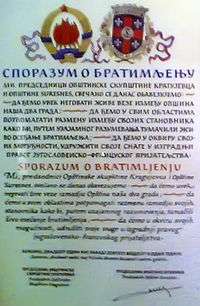
Twin towns – Sister cities
Kragujevac is twinned with:[37]
|
Partnerships and cooperations
The town has other forms of cooperation and city friendship similar to the twin/sister city programmes with:
|
Gallery
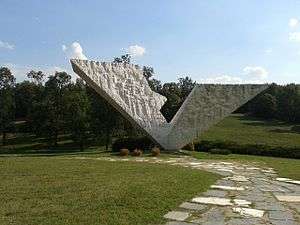
 Description Monument to slain people from Šumadija in the wars
Description Monument to slain people from Šumadija in the wars Stone lion in Šumarice park, World War I memorial
Stone lion in Šumarice park, World War I memorial Zastava main gate
Zastava main gate.jpg) Densely populated city quarters
Densely populated city quarters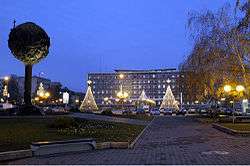 City center
City center
See also
| Wikimedia Commons has media related to Kragujevac. |
- List of places in Serbia
- University of Kragujevac
- Faculty of Economics
- Šumarice Memorial Park
- Kragujevac massacre
- Knjaževsko-srpski teatar
- Joakimfest
- Arsenal Fest
- First Kragujevac Gymnasium
- Šumadija fairground
- Gruža Lake
References
- ↑ "Human resources" (PDF). Statistics office of Serbia. Retrieved 16 November 2011.
- ↑ Archived 27 November 2014 at the Wayback Machine.
- ↑ "Tapu Tahrir Defteri 491: Ottoman government: Free Download & Streaming Internet Archive". Archive.org. Retrieved 12 August 2015.
- ↑ "Map of the Belgrade Pashaluk" (GIF). Terkepek.adatbank.transindex.ro. Retrieved 12 August 2015.
- ↑ "Kočina Krajina". Projekat Rastko. Retrieved 6 January 2016.
- ↑ "Photos of San Antonio - Images of San Antonio, Texas, USA". Members.virtualtourist.com. Retrieved 12 August 2015.
- ↑ "Kragujevac | Beautiful Serbia". Voiceofserbia.org. Retrieved 12 August 2015.
- ↑ "History of Serbian Culture". Srpskoblago.org. 4 January 1994. Retrieved 12 August 2015.
- ↑ "Kragujevac (Stadt)". En.europeonline-magazine.eu. 21 October 1941. Retrieved 12 August 2015.
- ↑ "Kragujevac 1918". telecom.gov.sk. Retrieved 4 August 2016.
- ↑ "Knjaževsko-Srpski Teatar". Joakimvujic.com. Retrieved 12 August 2015.
- ↑ "Kragujevac: Bed and breakfast in Kragujevac, Serbia". Hotel LAMA. 21 October 1941. Retrieved 12 August 2015.
- ↑ Carl K. Savich. "German Occupation of Serbia and the Kragujevac Massacre". Antiwar.com. Retrieved 16 September 2011.
- ↑ "Blic Online: "Engleska krvava bajka" u Kragujevcu". Blic.co.rs. Retrieved 16 September 2011.
- ↑ Stevan K. Pavlowitch (2008). Hitler's new disorder: the Second World War in Yugoslavia. Columbia University Press. p. 62. ISBN 0-231-70050-4.
- ↑ "Monument to the executed pupils (Kragujevac, Serbia): Address, Attraction Reviews". TripAdvisor. Retrieved 12 August 2015.
- ↑ Krvava Bajika profile, sites.google.com; accessed 2 August 2015.
- ↑ . Voice of Serbia http://voiceofserbia.org/serbia/node/152. Retrieved 6 January 2016. Missing or empty
|title=(help) - 1 2 "Welcome to Zastava-arms". Zastava-arms.rs. Retrieved 12 August 2015.
- ↑ ""Collateral damage" and the workers of the Zastava factory". Marxist.com. Retrieved 12 August 2015.
- ↑ "Monthly and annual means, maximum and minimum values of meteorological elements for the period 1981-2010" (in Serbian). Republic Hydrometeorological Service of Serbia. Retrieved 15 September 2012.
- ↑ "Kragujevac-City Tour - Kuća Čolovića". Kucacolovica.com. Retrieved 12 August 2015.
- ↑ "City Tourist Organization of Kragujevac". http://www.gtokg.org.rs. Retrieved 9 January 2016. External link in
|publisher=(help) - ↑ . Šumadija sajam http://www.sumadijasajam.rs/index.php/o-nama. Retrieved 6 January 2016. Missing or empty
|title=(help) - ↑ "Људски ресурси: Званичан сајт града Крагујевца". Kragujevac.rs. Retrieved 12 August 2015.
- ↑ "Инфраструктура: Званичан сајт града Крагујевца". Kragujevac.rs. Retrieved 12 August 2015.
- ↑ "Образовање: Званичан сајт града Крагујевца". Kragujevac.rs. Retrieved 12 August 2015.
- ↑ "Dobrodošli na skolazagluve.edu.rs - Škola za gluve Kragujevac". Skolazagluve.edu.rs. 27 January 2015. Retrieved 12 August 2015.
- ↑ "Музичка школа "др Милоје Милојевић"". Muzicka-kg.com. Retrieved 12 August 2015.
- ↑ "Škola Vukašin Marković". Sosovukasinmarkovickg.edu.rs. Retrieved 12 August 2015.
- ↑ "University of Kragujevac". Kg.ac.rs. 21 May 1976. Retrieved 12 August 2015.
- ↑ "Introduction". Ub.kg.ac.rs. 5 June 1985. Retrieved 12 August 2015.
- ↑ "National Museum of Kragujevac". Retrieved 6 January 2016.
- ↑ "Old Foundry Museum". Retrieved 6 January 2016.
- ↑ "Federation of International Bandy-About-About FIB-National Federations-Serbia-Serbia".
- ↑ "24. седница ГИК-а - Седнице: Званичан сајт града Крагујевца". Kragujevac.rs. Retrieved 28 May 2012.
- ↑ "Kragujevac Twin Cities". © 2009 Information service of Kragujevac City. Retrieved 24 December 2015.
- ↑ "Bielsko-Biała - Partner Cities". © 2008 Urzędu Miejskiego w Bielsku-Białej. Retrieved 10 December 2008.
- ↑ "Mostar Gradovi prijatelji" [Mostar Twin Towns]. Mostar Official City Website (in Macedonian). Archived from the original on 30 October 2013. Retrieved 19 December 2013.
- ↑ "Opole Official Website - Twin Towns". (in English and Polish) © 2007-2009 Urząd Miasta Opola. Retrieved 18 June 2009.
- ↑ Vacca, Maria Luisa. "Comune di Napoli-Gemellaggi" [Naples - Twin Towns]. Comune di Napoli (in Italian). Archived from the original on 22 June 2013. Retrieved 8 August 2013.
External links
| Wikivoyage has a travel guide for Kragujevac. |
- City of Kragujevac official website
- University in Kragujevac official website
- Faculty of Economics of the University in Kragujevac official website






